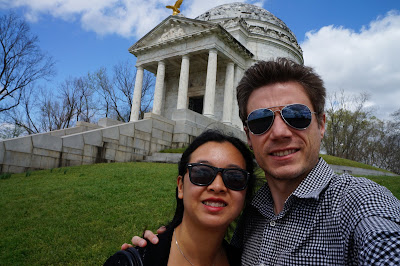We just spent two nights in Mississippi, one in the Mississippi Petrified Forest, and one in the nearby city of Vicksburg. Here is our trip so far, with one dot where we slept each night:
(Some of these stops were just rest stops, this is why we have no blog post and nothing to say about Tucson in Arizona, or Dallas in Texas.)
We camped the RV in the campground of the Mississippi Petrified Forest itself, which was very nice. The surroundings were peaceful and quiet, unlike the campgrounds we stay at in or near some of the bigger cities:
The next day we drove to Vicksburg, which is the site of an important battle during the Civil War. Sitting on bluffs, and flanked by the Mississippi river, the town was a natural fortress and was the last city on the Mississippi river still in the hands of the Confederates. After multiple battles and a siege, it eventually fell in the hands of Union soldiers, which cut the Confederate's territory in half (East and West of the Mississippi).
A
military park was established around the town, where a paved road took us a few miles through the bluffs where remnants of trenches are still visible. The park is sprinkled with plaques, statues, and little monuments describing which Confederate division fought which Union division on that day.
 |
| Shirley House: the only remaining structure from that era. |
The most interesting piece of the military park was the
USS Cairo boat which was sunk in 1861 when attacking Vicksburg, and 100+ years later was rediscovered at the bottom of the Mississippi river and restored:
 |
| They made seven of these ironclad warships in 100 days, but only this one was salvageable. |
 |
| Vicksburg has one of the largest burial grounds for the men who died in the civil war. |
 |
| Shot of the Mississippi. |
 |
| Notice the remnants of trenches, built zigzaging in order to make it harder for the enemy to aim and shoot at the heads of those running in the trenches. |
We spent just a little time in the city of Vicksburg itself:
 |
| Near the old courthouse. |
Vicksburg was the place were Coca-Cola was first bottled. The shop doing that is now a "museum" (not worth the $3.50 price of admission—there is too little memorabilia to make it worth it):
 |
| This was about the only interesting exhibit: an old machine to carbonate the Coca-Cola bottles. |
 |
| At the soda fountain. |
Next stop: New Orleans!






































































